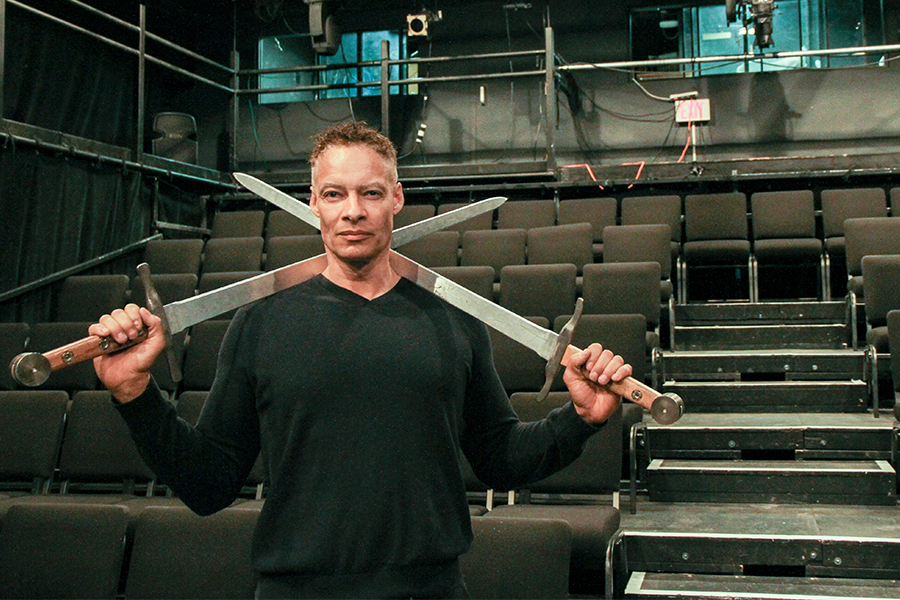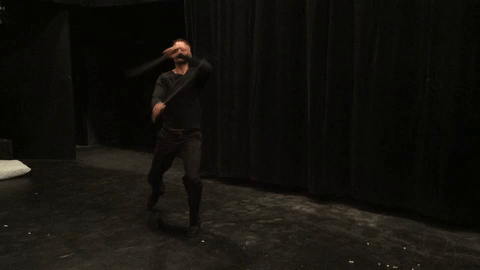
Fight club on campus
In a way, Iain Rose encourages his students to pick fights with one another.
By Lesley Porter
Rose teaches a second-year stage combat class in the Department of Drama, giving students a taste of what they may have to do if they are cast in a play where some type of fight or physical combat is required.
But there is more to it than wild swinging and clanging weapons. Rose teaches the methodologies of combat relative to its place in history, as well as the proper choreography involved, to make a fight scene look realistic on stage.
"Our purpose is to help the actor make sense of their character and to facilitate the action so that the story is told seamlessly," said Rose, who has been teaching the class since 2001. "Hopefully there will be an exciting fight as well."
It was an interest in martial arts that roped him into the world of theatrical combat. After he finished high school, he promptly started taking martial arts classes. He started with karate and a Chinese martial art called wushu, which helped him understand the esthetics of the practice. "It's very showy in its presentation," said Rose, who is also the technical director in the department. "Through doing that I was able to get a good eye for what looked good." He pursued other forms of the sport—including tai chi chuan, aikido and hapkido—becoming broadly proficient in each of them.
In 1994, he saw an advertisement for Fight Directors Canada (FDC), an organization and certification body for combat artists. The ad, which featured "a swashbuckling gentleman with a musketeer hat holding a cloak and a rapier and a dagger," was promoting a stage combat workshop. He attended, finding another outlet for his extensive martial arts experience.
Since then, he has gone on to do more training with FDC and become a certified instructor of unarmed combat, single sword and quarterstaff, a type of European pole weapon. He teaches the first two styles in his class, and at the end of the term each student performs these techniques in front of a live audience.
Rose focuses on European-region martial arts in the class—though not as well-known as its Asian counterpart, it carries the same legitimacy and foundation, particularly in sword combat.
"Before gunpowder became mainstream and projectile sidearms made edged weapons almost obsolete, the sword was king," he said. "Whoever had the better sword technology, would have the better edge. And whoever had the better weapons would dominate the battlefield." Students can practice with replica swords, many of which Rose made himself or had made for the class. These range from the xiphos, a short, thrusting sword popular in ancient Greece, to the rapier, a long, elegant piercing sword from 16th century Italy, to variations of fencing swords used by competitors in the sport.
The art of putting on a compelling fight has come a long way, Rose explained. Before stage combat was taught as a useful skill, stage directors would bring in a fencing instructor or boxing coach to teach the dynamics of fighting, or seek out audience members with fighting experience. "Or worse," he recalled, "the director—who would have no training in martial combat—would try to choreograph a fight, usually with questionable consequences."
So while there is an urge to be exceedingly violent in a fight, that is simply not how it is done in a dramatic play scene. He used two actors in a sword fight as example of maintaining a safe distance from each other to make the scene look realistic.
"If you're within distance, then I can hit you. If you're maintaining a safe distance, even if I make a mistake, I'm never going to hit you," he said. "Safe distance is determined by correct and proper footwork. This is why it takes a lot of rehearsal to be able to discipline your feet to be able to keep that consistent, safe distance."
Additionally, many plays that have fights in them often lack the choreography needed to make it look realistic. "Where people like myself come in is, we fill in that blank: ‘Ok, how do we do it to meet that end and carry the story on?'"

